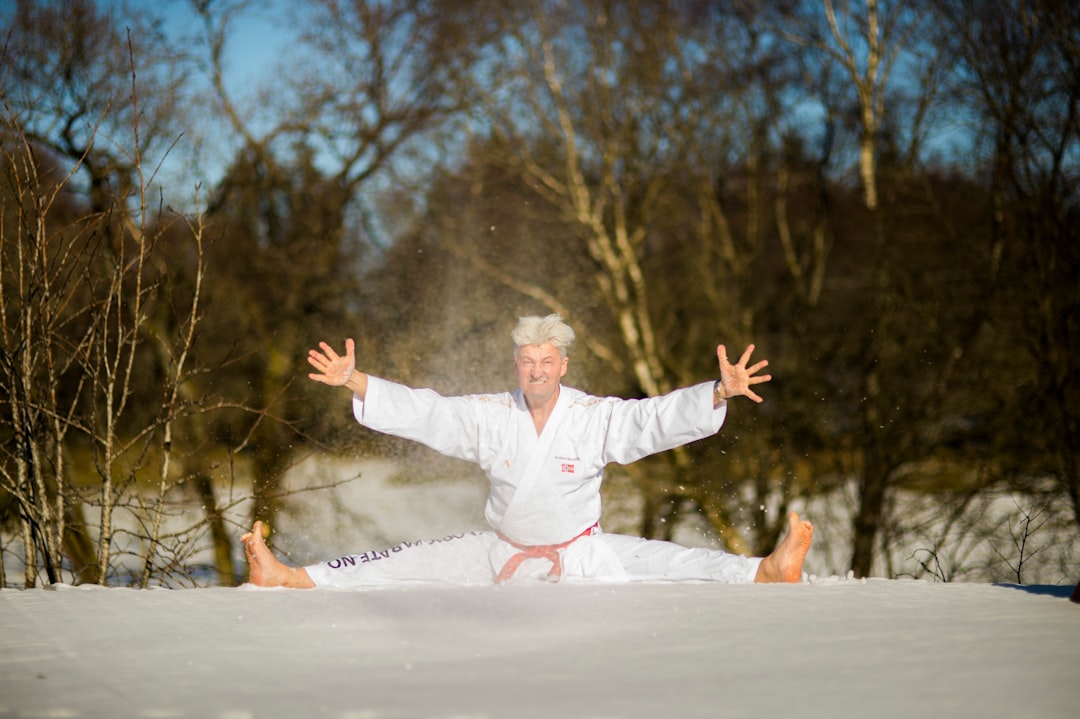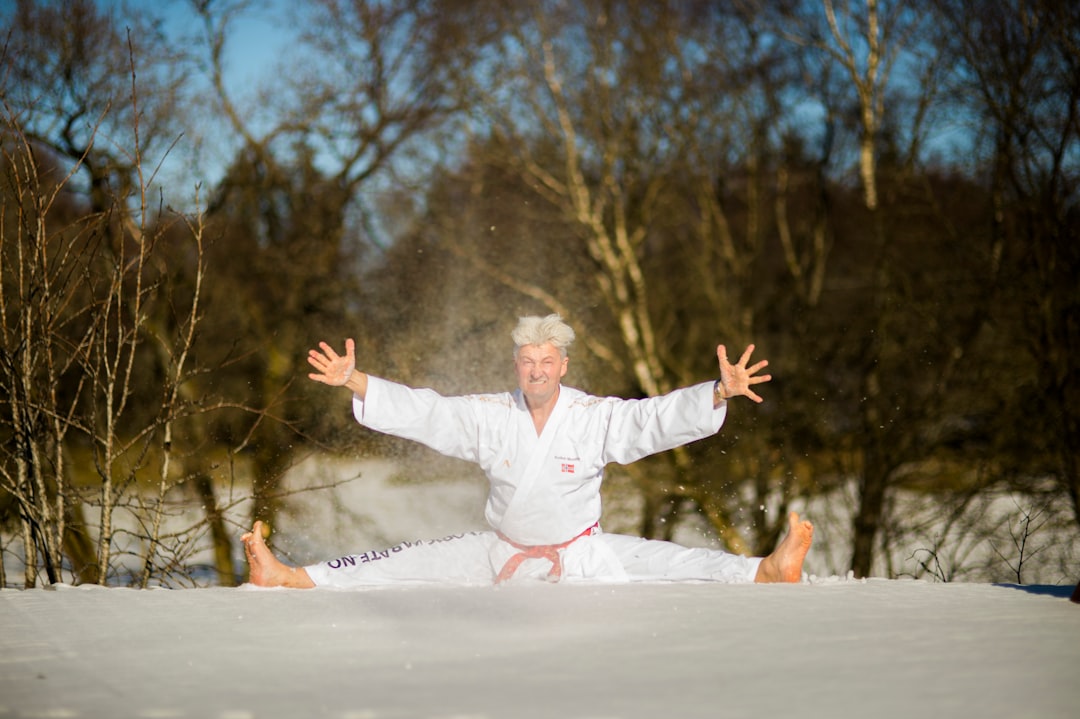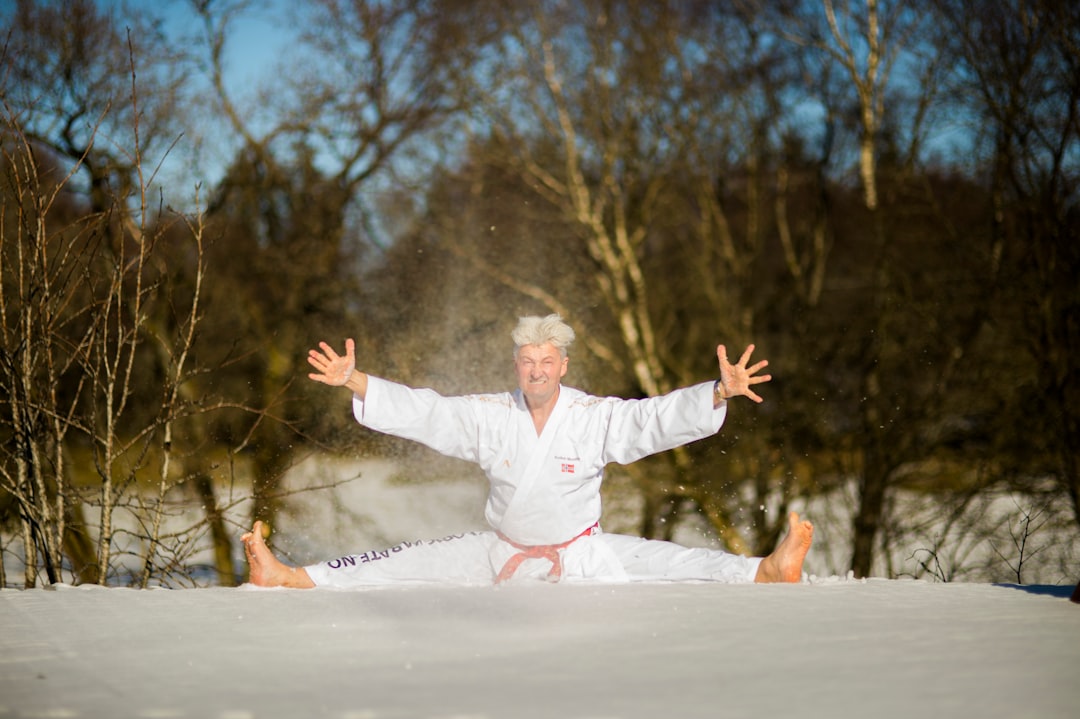Choosing the correct karate outfit, known as a keikogi or gi, is essential for both comfort and performance in karate practice or competition. The traditional white gi not only symbolizes unity among martial artists but also offers flexibility necessary for seamless movements. High-quality materials in the gi and accompanying footwear like obi belts and zori slippers ensure optimal grip and stability, which are crucial for maintaining balance. Additionally, safety equipment such as a protective mouthguard and groin protector is non-negotiable to prevent dental and groin injuries during contact training. Hand, shin, and forearm protectors are vital in full-contact styles to safeguard against impact injuries. Staying hydrated with a water bottle is also key for maintaining performance levels throughout the session. In essence, a well-fitting gi, protective gear, appropriate footwear, and a water bottle form the core of an effective karate practice kit, ensuring both safety and traditional respect in your training.
Embarking on your karate journey or preparing for your next session? Understanding what to bring for karate is crucial for both beginners and seasoned practitioners. This article meticulously outlines the essential elements of a karate outfit, ensuring you’re properly attired for peak performance. We’ll then guide you through a comprehensive practitioner’s packing list, highlighting the must-have items every karateka should include in their kit. Finally, we’ll explore how to accessorize for success, enhancing your training with supplementary gear designed to optimize your experience and technique. Whether you’re stepping onto the dojo floor or fine-tuning your skills, this guide will equip you with the knowledge necessary for a well-prepared karate practice.
- Essential Elements of a Karate Outfit: Gearing Up for Optimal Performance
- The Practitioner's Packing List: Must-Have Items for Your Karate Kit
- Accessorizing for Success: Enhancing Your Training with Supplementary Karate Gear
Essential Elements of a Karate Outfit: Gearing Up for Optimal Performance

When preparing for a karate session or competition, selecting the right outfit is crucial for both comfort and performance. A karate outfit, known as a keikogi, serves as the primary garment for practitioners. This traditional white jacket and trousers not only symbolize the uniformity of the martial artist but also allows for ease of movement and mobility during practice or sparring. The keikogi is designed with a heavy emphasis on flexibility, ensuring that every strike and motion can be executed with precision. Additionally, the choice of footwear is significant; karate-ka often wear obi belts to secure their kimono-like garments and may opt for canvas or leather zori slippers for grip and stability during movements. Are the keikogi and zori you choose made from high-quality materials that enhance your performance without causing unnecessary friction or discomfort? Do they allow for a full range of motion, enabling you to execute techniques with fluidity and grace? Ensuring that your karate outfit meets these criteria is essential for both safety and effectiveness in your training. A well-fitted keikogi, coupled with appropriate footwear, will not only contribute to a better practice session but also help in maintaining the respect for the traditional aspects of the sport.
The Practitioner's Packing List: Must-Have Items for Your Karate Kit

When preparing for your karate practice, it’s crucial to ensure that you have all the necessary items to engage in the training effectively and safely. Your karate kit should include a well-fitted karate outfit, which is essential for comfort and mobility during exercises and sparring. The traditional white gi is a staple for many styles of karate, but depending on your style or preference, you might also opt for a judogi or bando for training purposes. A gi should be made of a durable fabric that allows for ease of movement while being able to withstand the rigors of practice. Additionally, ensure your gi fits properly; it shouldn’t be too tight or too loose, as this can affect your range of motion and comfort.
Beyond the gi, other essential items for your karate kit include a protective mouthguard to safeguard your teeth during impact training and sparring. A pair of protective gloves will also help protect your hands from injury when practicing strikes on pads or during sparring sessions. Don’t forget about foot protection; karate dojos often require footwear designed for martial arts, such as mawashi-do or kendogi, which offer both grip and protection for your feet. Lastly, a bottle of water is important to keep hydrated throughout the session, as staying hydrated is key to maintaining peak performance during intense training. Remember, the right gear not only supports your physical well-being but also enhances your training experience. What are the essential items you need for your karate kit? A karate gi that fits properly, a protective mouthguard, martial arts gloves, and appropriate footwear are must-haves. A water bottle to stay hydrated is also an important addition to your packing list.
Accessorizing for Success: Enhancing Your Training with Supplementary Karate Gear

When gearing up for your karate training, selecting the right outfit is crucial to ensure maximum comfort and mobility. What type of garment should you be wearing for optimal performance during your practice sessions? A karate outfit called a ‘gi’ is traditionally recommended for its durability and flexibility. The gi, which is a white cotton uniform, allows for ease of movement and is designed to withstand the rigors of repeated techniques and throws. It’s important to choose a well-fitting gi that isn’t too tight or too loose; one that doesn’t hinder your movements or cause discomfort during practice. Additionally, for protection and safety, a mouthguard and groin protectors are advisable, especially when practicing contact techniques or sparring. These supplementary pieces of gear can prevent injuries and ensure that you can continue your training without interruption. Are protective pads necessary for all types of karate? Protective pads such as hand guards, shin guards, and forearm protectors are often used in full-contact styles of karate to safeguard against impact injuries. These accessories become essential when the training involves high-impact strikes or kicks, making them a wise investment for any serious practitioner. Whether you’re practicing traditional forms or engaging in competitive sparring, having the right protective gear can significantly enhance your training experience and reduce the risk of sustaining injuries.
In conclusion, whether you’re stepping onto the mat for the first time or honing your skills for a tournament, ensuring you have the appropriate karate outfit and gear is key to maximizing your performance and comfort. From the fundamental elements of a karate outfit called Gi to the comprehensive Practitioner’s Packing List, and the strategic addition of accessories that enhance training, you are now well-equipped to select items that align with your personal needs and level of expertise. Remember, the right attire and gear not only contribute to optimal physical condition but also instill a sense of readiness and focus that is essential for the discipline and practice of karate.
